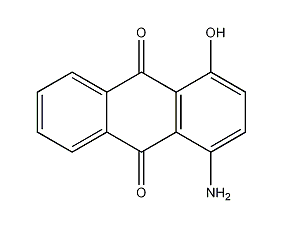1-amino-4-hydroxyanthraquinone


Structural formula
| Business number | 038T |
|---|---|
| Molecular formula | C14H9NO3 |
| Molecular weight | 239.23 |
| label |
1-amino-4-hydroxy-9,10-anthracenedione, 1-hydroxy-4-aminoanthraquinone, Disperse Orange HFFG, 1-Hydroxy-4-aminoanthraquinone, Celliton Fast Pink B, Disperse Red 15, Anthraquinones |
Numbering system
CAS number:116-85-8
MDL number:MFCD00001223
EINECS number:204-163-0
RTECS number:CB5600000
BRN number:None
PubChem ID:None
Physical property data
1. Characteristics: Red powder.
2. Density (g/mL,20℃) : Undetermined
3. Relative vapor density ( g/mL,Air =1): Undetermined
4. Melting point (ºC):207~ 208
5. Boiling point (ºC,normal pressure): Undetermined
6. Boiling point (ºC, KPa): Undetermined
7. Refractive index: Undetermined
8. Flashpoint (ºC): Undetermined
9. Specific rotation (º): Undetermined
10. Autoignition point or ignition temperature (ºC): Undetermined
11. Vapor pressure (mmHg, ºC): Undetermined
12. Saturated vapor pressure (kPa, ºC): Undetermined
13. Heat of combustion (KJ/mol): Undetermined
14. Critical temperature (ºC): Undetermined
15. Critical pressure (KPa): Undetermined
16. Oil and water (octanol/Log value of the partition coefficient for water: undetermined
17. Explosion upper limit (%,V/V): UndeterminedPolarizability ( 10-24cm 3):25.68
Compute chemical data
1. Reference value for hydrophobic parameter calculation (XlogP): None
2. Number of hydrogen bond donors: 2
3. Number of hydrogen bond acceptors: 4
4. Number of rotatable chemical bonds: 0
5. Number of tautomers: 12
6. Topological molecule polar surface area 80.4
7. Number of heavy atoms: 18
8. Surface charge: 0
9. Complexity: 381
10. Number of isotope atoms: 0
11. Determine the number of atomic stereocenters: 0
12. Uncertain number of atomic stereocenters: 0
13. Determine the number of chemical bond stereocenters: 0
14. Number of uncertain chemical bond stereocenters: 0
15. Number of covalent bond units: 1
Properties and stability
Stable at normal temperature and pressure, avoid contact with Strong oxidants, acid anhydrides, acid chlorides Contact.
Storage method
Store in a cool, ventilated warehouse. Keep away from fire and heat sources. Protect from direct sunlight. The packaging is sealed. They should be stored separately from oxidants, acid anhydrides and acid chlorides, and avoid mixed storage. Equipped with the appropriate variety and quantity of fire equipment. Suitable materials should be available in the storage area to contain spills. Ecology: This substance is harmful to the environment. It is recommended not to let it enter the environment.
Synthesis method
1. From 1-hydroxyanthraquinone through nitration and reduction; 2. Phthalic anhydride and p-aminophenol condense and close the ring; 3. 1-Isomerization of hydroxylaminoanthraquinone; 4. 4-Brome-1-Aminoanthraquinone hydrolysis, etc. Made by method.
Purpose
Mainly used as disperse blueRRL, disperse red 15Intermediates of vat dyes. And used as analytical reagents: used to detect beryllium, lithium, and boron ions. The limit concentrations are: beryllium10-6, lithium0.07% , boron 10-5.
rphan” align=left>4. 4-Br-1-Aminoanthraquinone hydrolysis and other methods Got.
Purpose
Mainly used as disperse blueRRL, disperse red 15Intermediates of vat dyes. And used as analytical reagents: used to detect beryllium, lithium, and boron ions. The limit concentrations are: beryllium10-6, lithium0.07% , boron 10-5.